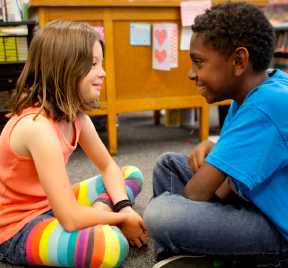What are your SEL essentials?
 As every educator knows, it takes grace, hard work, and a tremendous amount of empathy and compassion to navigate successfully through the school year.
As every educator knows, it takes grace, hard work, and a tremendous amount of empathy and compassion to navigate successfully through the school year.
In the years since the pandemic, we believe that more than ever, we need a mindset and teaching stance that integrate social and emotional learning (SEL).
In fact SEL essentials are vital ingredients in creating the supportive learning communities that our students need to thrive.
The SEL Essentials Blog Series
To that end, we’ve written this blog series to share our essential strategies and insights about building and sustaining caring, robust learning communities—the kind of communities in which all students feel valued, supported, and able to take the learning risks they need to grow.
In this series, we’ll draw upon wisdom gleaned from our 40-plus years of conducting research, developing programs, and collaborating with educators.
The SEL Essentials series will have six parts:
Part 1– “What Do We Prioritize? Three SEL Essentials for Beginning the Year”
We explore how to open the year with our students’ social and emotional needs in mind and consider what the essentials are, addressing topics such as:
- How might we approach building relationships and developing a sense of belonging among students?
- How might we manage our classrooms in a caring and respectful way?
Part 2 – “Supporting Students Who Are Dealing with Trauma”
We explore questions including:
- How might we support students who experience or have experienced trauma?
- What practices and strategies are most effective?
Part 3 – “Prosocial Skills: Anchors in a Storm”
We discuss the kinds of skills students need to contribute to and take care of our community. Specifically, we dig into:
- What skills do students already have that we can build upon?
- What skills do they need so they can solve problems, collaborate, and contribute to the classroom community?
- How might we support students in developing these skills in meaningful ways?
Part 4 – “Reimagining Our Discipline Practices”
We offer ways to examine and rethink our approach to discipline, exploring questions such as:
- How do we make sure our discipline practices are not undermining the work we are doing to build relationships and foster SEL?
- How do we take a proactive, teaching-and-learning approach to discipline?
- What are alternatives to discipline systems based on rewards and punishments?
- How might our instructional practices be unintentionally affecting student behaviors in our classrooms?
Part 5 – “SEL Essentials at Mid-Year: How Do We Reconnect, Rebuild, and Begin Again?”
January is an opportunity for a fresh start, particularly when attending to SEL for our students. We consider how we might revitalize our learning communities for the second half of the school year, exploring questions such as:
- How can we reconnect with our students and bolster their sense of belonging?
- Why and how might we reflect on our current SEL essentials?
- What do our students need most right now, and how might we best support them?
Part 6 – “SEL Essentials at Year’s End: Honoring the Learning of the School Year” (Coming Soon)
Old habits die hard. Even as educators have learned so much in these post-pandemic years about the importance of addressing students’ social, emotional, and mental health needs, it’s human nature to revert reflexively back to our familiar patterns, our comfortable assumptions, and our “tried-and-true” ways of approaching the work.
However, we don’t have to—and emphatically should not—go “back to normal.” Nor should we unquestioningly accept prevailing judgments about how teaching and learning have fared in recent years. In this blog post, we’ll explore:
- How our students have surprised us and challenged our expectations
- Why educators must resist a deficit mindset and honor students’ lived experiences and learning
- The importance of building deeper relationships so that all students feel safe, connected, challenged, and supported
While we are eager to share our thoughts with you, we do so with the humble acknowledgement that there is no one right way to do this work.
Our hope is simply to provide a set of guideposts that help you chart your own path through the year.
***
Ready to get started? Read the first post in the SEL Essentials blog series, “What Do We Prioritize? Three SEL Essentials for Beginning the Year.”
